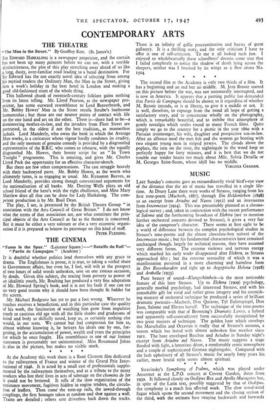MUSIC
LAST Sunday's concerts gave an extraordinarily vivid bird's-eye view of the distance that the art of music has travelled in a single life- time. At Drury Lane there were works of Strauss, ranging from his first tone-poem (Macbeth, 1887), through Ein Heldenleben (1898) to an excerpt from Ariadne auf Naxos (1912) and an intermezzo from Intermezzo (1924). This was presumably planned as a chrono- logical survey ; and, taken in conjunction with the recent performance of Salome and the forthcoming broadcast of Elektra (not to mention further orchestral concerts devoted to Strauss), it gives a very fair idea of the composer's character. There seems at first sight to be a world of difference between the complex psychological studies in Strauss's tone-poems and the almost chocolate-box naivete of the Intermezzo music' but his fundamental characteristics have remained unchanged though, largely for technical reasons, they have assumed very different forms. The extreme violence and nervous energy which marked his early works disappeared after Elektra, as Strauss approached fifty ; but the extreme sensuality of which it was a manifestation persisted in a more charming and harmless form in Der Rosenkavalier and right up to Aegyptische Helena (1928) and Arabella (1933).
Pure beauty of sound—Klangschonheit—is the most noticeable feature of this later Strauss. Up to Elektra (1909) psychology, generally morbid psychology, had interested Strauss and with his remarkable gift for vivid and rather gross imagery and his astonish- ing mastery of orchestral technique he produced a series of brilliant dramatic portraits—Macbeth, Don Quixote, Tyl Eulenspiegel, Don Juan, Salome and Electra herself. The technique of the tone-poems was comparable with that of Browning's Dramatic Lyrics, a hybrid and apparently self-contradictory form successfully manipulated by two great masters of technique. The golden haze which envelops the Marschallin and Octavian is really that of Strauss's autumn, a season which has lasted with almost unbroken fine weather since 1911. The haze enveloped Bacchus and Ariadne in Sunday night's excerpt from Ariadne auf Naxos. The music suggests a stage flooded with light, a luxurious decor, a comfortably erotic atmosphere and a couple of sophisticated German nightingales. Compared with the lush upholstery of all Strauss's music for nearly forty years his
earlier, more brutal style seems almost spiritual. * * * *
Stravinsky's Symphony of Psalms, which was played under Ansermet at the L.P.O. concert at Covent Garden, dates from 1930. It followed closely on Oedipus Rex and Apollo Musagetes but, in spite of the Latin text, possibly suggested by that of Oedipus, the symphony is a much less affected work. The slow wood-wind fugue which opens the second movement and the closing section of the third, with the ostinato bass swaying backwards and forwards like a pendulum, are wonderfully effective. They suggest Stravinsky's theatrical past rather than h:s symphonic future, but that need worry no one but perhaps Stravinsky himself. It was an old Puritan prejudice that connected the theatre with insincerity, and Stravinsky has as much right to suggest a ballet in his Symphony of Psalms as Verdi had to suggest an opera with his Requiem. Any liturgical form of worship is, after all, a slow-motion sacred ballet, and the more "fully, choral" it is the nearer the approach to opera too ; the question of insincerity does not arise in the one case more than the other. Stravinsky (or Verdi) could only be accused of insincerity if he wrote " religious " music in a forced and unnatural style which did not express his complete personality. Spontaneity is not a characteristic of Stravinsky's music in any case : but a planned economy is not, after all, necessarily bad. MARTIN COOPER.



































 Previous page
Previous page